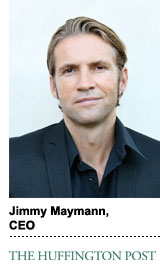 When Jimmy Maymann sold content distribution company GoViral to AOL in 2011, some expected the Danish entrepreneur to take his share of the $96.7 million exit and chase new startup opportunities.
When Jimmy Maymann sold content distribution company GoViral to AOL in 2011, some expected the Danish entrepreneur to take his share of the $96.7 million exit and chase new startup opportunities.
Instead, he stayed on at AOL as SVP for international, much to even his surprise.
“I always knew I didn’t want to stay on once the company was acquired,” he remarked. “I left for a month and then came back.”
One week after AOL bought GoViral came the company’s $315 million purchase of The Huffington Post. This, to Maymann, signaled an opportunity to build.
“Really, Arianna Huffington and Tim Armstrong said, ‘If we want to take HuffPost to a global level, then we really need a partner for Arianna who focuses on the business side while she focuses on editorial.’”
He was formally named CEO of Huffington Post Media Group in December 2012.
It’s no secret the publication in recent years has struggled to turn a profit. Maymann says that tide is turning thanks to emphasis on global expansion and video monetization, a move right in line with AOL’s broader growth strategy around video.
Maymann spoke with AdExchanger about digital developments at HuffPost and bringing the brand to global markets.
AdExchanger: One of your first responsibilities at Huffington Post was internationalizing the brand. What markets are you tackling?
JIMMY MAYMANN: We spent quite a bit of time doing market analysis. We looked at criteria such as Internet, broadband and smartphone penetration, online advertising spend, competition in the market. There were very different variables in each market and we ended up with an initial list of 15 markets. It’s Canada, the big five in Europe, the BRIC markets, Japan, Korea, Mexico [and select regions in] Africa. In Brazil we launched in January because with the World Cup and Olympics coming up, there’s a lot of advertiser interest and a high-growth market with a large audience. We’ve launched 11 out of those 15 and have grown from 45 million unique visitors per month to 94 million UVs globally. Two and a half years ago, [Huffington Post] was a very US-centric business for us. Our international business is now 44% of our total business.
What markets are you undertaking now? What challenges await you?
We’re having conversations with Mexico, where we expect to launch next year. We’re having conversations in Russia and China is the last of the 15 markets we haven’t launched in. China is a hybrid. It’s more difficult [evaluating] the way we would be perceived in China. We see ourselves not as a news site, but a news platform. A place where we not only bring news, but start conversations. If we go in to China, we need to really consider, “What’s the model that could work there?”
What’s a good measure of success in opening a new market?
We always create five-year plans. We always want to break even within two to three years, and always want to build businesses we feel can get into the top five in a news category because if you don’t get in there quick, you’re not going to get your fair share of the advertising market. In Brazil, we launched three months ago and we are already at 2 million UVs on a monthly basis, which is ahead of where we thought we’d be at this time. In general, that’s what we’ve seen in all the markets. We’re either on track or ahead of where we wanted to be both from a revenue and audience perspective, which is obviously why we keep doing this.
Obviously mobile adoption and infrastructure varies the world over.
Japan is truly a mobile-first market. When we talk about news consumption, 80-90% of all news consumption is happening via mobile devices there. We needed to have a very different approach and strategy. Most of the European markets we’ve gone into, perhaps one third are mobile at this point in time. [Then when you enter] those markets where suddenly you have a market where up to 90% of the consumption is actually by the mobile device, you have to think about, “What does that mean for your business?” It’s been a challenge, but at the same time a great learning experience. Japan taught us a lot we can bring back to the US as well.
How’s mobile uptick in the US?
[On the weekends] it has gone from one-third to 55% of our audience coming from mobile devices. We expect, on average this year, definitely more than half of our traffic will be mobile. It’s important both from a content and ad format perspective to capture the audience attention and value of it.
With video increasingly consumed on mobile, what’s that percentage been?
Not a high percentage yet. The user experience was not great on mobile for us and we’ve spent a lot of time getting that right. I think personally the banners on mobile are very annoying. It’s not a great format and from my perspective, I think video is one of the formats that obviously works very well on mobile and we want to make sure we have those formats working really well on mobile devices so advertisers can come to HuffPost and buy our audience cross-platform.
If we have a native solution running on the desktop, that native solution should translate into mobile and actually work in mobile in the same way so it fits the mobile and is not just taking desktop and placing it there. We’re in the process of rolling out native formats on mobile, so both video and native are things we can do on mobile devices in a much more intelligent way than we’ve been able to in the past. So from that perspective, we expect to see more mobile revenue and more engaged users on the devices themselves.
You’ve built HuffPost Live into a two-way broadcast with your audience. How do all of the video segments eventually mesh with editorial content?
Every segment is 20-25 minutes, which is great for the live experience, but obviously if you come after the fact for video on demand (VOD), you don’t want 20 minutes. You want it fast. For each segment every day we cut them down to different segments – two-minute segments being very popular. Every month, we have between 3,000-5,000 new clips placed in our library [for journalists to package with stories].
How does this affect the ad placement strategy?
From a monetization standpoint, it means I can do pre-roll or post-roll around that two-minute clip, so I have a better user experience and better monetization on my page, because I not only have banners, but videos on my page that have higher CPMs and since it’s not disrupting the experience, it’s a win-win.
That’s what we’ve seen with HuffPost Live. It’s allowed us to increase the insertion rate on our pages of video. In the US, we have around 2 billion page views so there are a lot of pages that didn’t have video before. Before, it was around 3% and the reason was, if we didn’t have contextually relevant video, just putting any (video) next to an article would not create a great user experience. If we’re drawing things in, we have to make sure its relevant and adding value. More than 65% of pages now have video insertions, which means we also have a huge video audience also on VOD and much better monetization capabilities on those pages because it’s a more premium unit and format.
How do you sell that inventory?
We have bigger runs across HuffPost that are on our sponsorship slate. They can be sold as a HuffPost package, but they can also be sold as part of the greater AOL package through AOL On where the advertiser can access our audience as well. There are different entry points, you can say, to our audience.
Everyone’s talking “original content” from parent company AOL to Yahoo and Amazon. What’s your view on it?
People are creating original, and bespoke content for the Web and I think that’s a good thing. I think that increases the overall user experience. AOL is doing it. They have the big upfront in about a month and a half’s time. When we first started HuffPost Live, we didn’t want to replicate TV programming, but I think we’ve also realized we should also have some programming, so we’re evaluating if we do two or three shows, what would they be and how do we make that unique to what we are as a brand? Certainly creating original programming, something that becomes an anchor point people can come back to at this time of day – that’s something I really want to follow. That’s definitely a mindset shift we’ve had based on all the data we’ve analyzed – what’s the audience after and where can we do more?
With that data, does “real-time” advertising get more interesting?
Agencies are always interested in new things, just as they’re interested in “real-time” advertising. We’ve tested that out with Digitas, where we’ve given them a slot on our front page, and let them control that with their advertisers so they could do whatever they want real-time. We need to get more learnings about this. Right now it’s a buzzword. But how does it actually work?
To do real-time, live advertising puts a lot of pressure on the advertiser because you need to act like a newsroom. You need to be set up in a very different way if you want to fill that with relevant brand content. I think that’s very interesting and obviously something we’re focusing a lot on ourselves. To be able to help brands get into this space, we launched HuffPost Partner Studio last year where we moved some editorial resources into the business side and some strategy people, so they could work with the advertisers on “what is the narrative?” and actually create the content that’s needed to get the native solutions to work.














